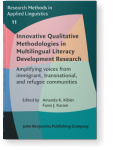Chapter 1
Introduction: Innovative paths in researching multilingual literacy development
Rethinking data, theory, and positionality
In this introductory chapter to the volume, Innovative
Qualitative Methodologies in Multilingual Literacy Development Research:
Amplifying Voices from Immigrant, Transnational, and Refugee
Communities, we situate the key aims of the collection in the
context of conceptual innovations in multilingualism, literacy, and equity.
To unlock the full potential of these recent developments, innovative
rethinking of methodological approaches is needed to keep pushing the
boundaries of our understanding of multilingual literacy development and to
further our ethical commitments to humanizing research. We describe selected
recent empirical studies in which qualitative literacy researchers have
begun to “rethink” data, theory, and positionality in their work before
presenting an overview of the contributions in this volume.
Article outline
- Introduction
- Resituating concepts in multilingual literacy development
- Resituating equity in multilingual literacy development
- Resituating research on multilingual literacy development
- Rethinking data
- Rethinking theory
- Overview of chapters in the volume
-
References
This content is being prepared for publication; it may be subject to changes.
